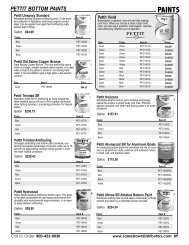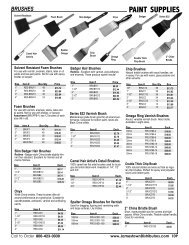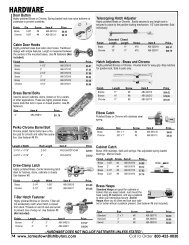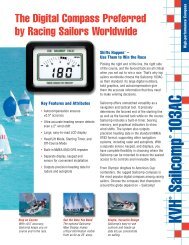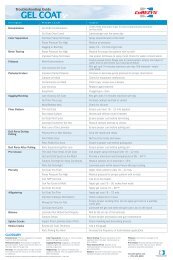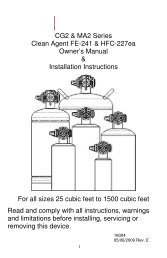technical manu al table of contents - Jamestown Distributors
technical manu al table of contents - Jamestown Distributors
technical manu al table of contents - Jamestown Distributors
Create successful ePaper yourself
Turn your PDF publications into a flip-book with our unique Google optimized e-Paper software.
In answer to your question, if you are looking for a “show qu<strong>al</strong>ity” finish, it is essenti<strong>al</strong><br />
that the finish is “dead flat”. This can only be accomplished with serious block sanding.<br />
In most cases, this style <strong>of</strong> sanding will remove more varnish than is necessary but does<br />
produce the “mirror finish that goes on forever” look. Just be aware <strong>of</strong> this. Chances are<br />
that your edges and possibly, the whole system will be thin. It takes extra care and<br />
usu<strong>al</strong>ly extra coats to produce this type <strong>of</strong> finish.<br />
Our best suggestion is to work towards something in between a “show qu<strong>al</strong>ity” and a<br />
“utility finish”. This will produce a better than accep<strong>table</strong> finish that will have lots <strong>of</strong><br />
staying power. We would rather see a not so smooth finish with occasion<strong>al</strong> sags than a<br />
too thin finish that has been sanded to death.<br />
Question:<br />
My 1956 17’ Chris-Craft Sportsman rubbed up against the dock during some rough<br />
weather and the varnish has been badly scratched in a couple <strong>of</strong> isolated places. The<br />
scratches didn’t damage the stain or gouge the wood. Is there a way to patch or<br />
“feather” the damaged sections or do I need to revarnish the whole side?<br />
Answer:<br />
To answer your question, we will assume that a single-part varnish or something similar<br />
was used on the boat. Two-part finishes due to their nature, are quite difficult to repair.<br />
Most boats similar to yours are finished with one-part so, hopefully we are making a safe<br />
assumption.<br />
It is good that the stain has not been affected. Touching up stain is possible but it is<br />
more difficult to match the color. Any varnish exposed to UV will change color. Therefore<br />
expect a little color difference when touching up the varnish. Once the new repaired area<br />
is exposed to the sun, it will eventu<strong>al</strong>ly blend in on its own. Essenti<strong>al</strong>ly, the damaged<br />
area needs to be lightly roughed up and built back up again with varnish. Be careful at<br />
this stage, as you are likely very close to the stain. Sanding through the stain will only<br />
create more problems. Start with a thin coat and slowly build back up again to a level<br />
consistent with the rest <strong>of</strong> the finish. Once achieved and if re<strong>al</strong>istic, sand the whole area<br />
and apply a fresh coat to <strong>al</strong>l.<br />
If the edges <strong>of</strong> the damaged area are nice and clean, it is best to fill the affected area<br />
with varnish using a very sm<strong>al</strong>l brush and being very careful with the paper. If however,<br />
the damaged area is uneven and jagged, consider the following: Free handing the area<br />
with a brush will only produce a “repaired” looking patch. We mask an area larger than<br />
the damaged spot with a pattern that suits the patch i.e. a diamond, triangular or<br />
rectangular shape. This will give you a nice section to work within and will produce a<br />
patch with clean, crisp lines. This is much more pr<strong>of</strong>ession<strong>al</strong> looking. As well, there is no<br />
chance <strong>of</strong> any loss <strong>of</strong> integrity where the damage meets the existing area.<br />
It is good practice to keep a sm<strong>al</strong>l bottle, similar to a nail polish bottle with the brush built<br />
into the cap, on board and filled with varnish for emergency repairs where bare wood<br />
may be exposed.



